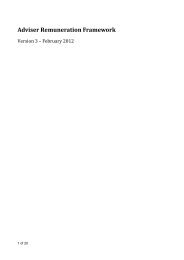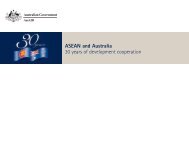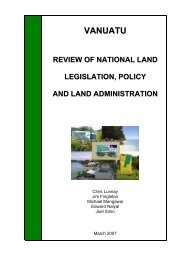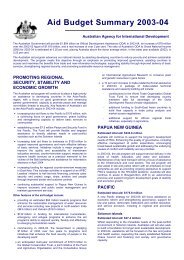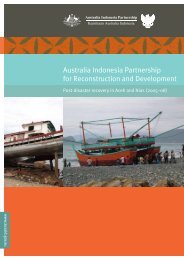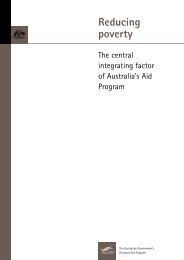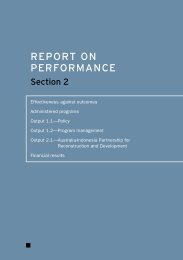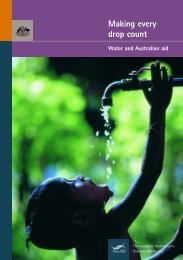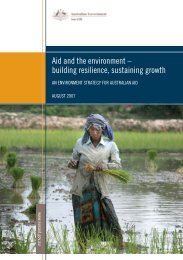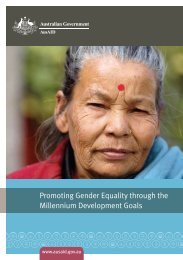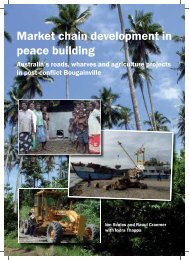Australian Aid to PNG - AusAID
Australian Aid to PNG - AusAID
Australian Aid to PNG - AusAID
Create successful ePaper yourself
Turn your PDF publications into a flip-book with our unique Google optimized e-Paper software.
only assist within the context of the partner government’s own policies,practices and management capacity.The need for much more rigorous moni<strong>to</strong>ring, measurement, and evaluation of<strong>Australian</strong> aid is crucial given the volume of <strong>Australian</strong> funding for Papua NewGuinea’s development since independence, and its significant developmentchallenges. Such performance information needs <strong>to</strong> be accessible not only atthe activity and sec<strong>to</strong>r level but also, importantly, at the broadest level, in thecontext of Papua New Guinea’s development policies and developmentprogress, as well as in the context of Australia’s own objectives.<strong>AusAID</strong> already has a range of systems in place that could be used <strong>to</strong> improvethe quality of baseline data and regular moni<strong>to</strong>ring and assessment of projectand sec<strong>to</strong>r-level performance. At present, logical framework matrices(logframes) are prepared for all aid activities, which identify performanceindica<strong>to</strong>rs and link these <strong>to</strong> higher order objectives as well as <strong>to</strong> project-specificoutputs. These should (and usually do) establish a framework for the sort ofbaseline data that ought <strong>to</strong> be collected, and the extent of ongoing moni<strong>to</strong>ringthat would be required <strong>to</strong> assess performance against impact indica<strong>to</strong>rs. Theresults of such moni<strong>to</strong>ring should routinely be documented as part of theexisting reporting requirements for projects. This would then allow moreeffective impact assessment of project outcomes and achievements at projectcompletion. It would also provide a valuable basis for the conduct ofsubsequent ex-post or cluster evaluations.The Project Completion Report (PCR) format in AusGUIDE explicitly requires themanaging contrac<strong>to</strong>r <strong>to</strong> make a preliminary judgement about the impact of theactivity. In practice however, most reporting is confined <strong>to</strong> specific, verifiableoutputs. Few project completion reports comment on broader developmentimpacts and, where they do, the comments tend <strong>to</strong> be confined <strong>to</strong>unsubstantiated assertions. This is probably because baseline data were notrequired <strong>to</strong> be collected at the outset of most projects, making subsequentperformance assessment difficult. The paucity of performance information is alsoa function of the very small number of ex-post evaluations that have been done.Improving the information base on which <strong>to</strong> assess the development impact ofAustralia’s aid requires some relatively straightforward changes in <strong>AusAID</strong>’scurrent processes, <strong>to</strong> develop an integrated moni<strong>to</strong>ring and evaluation system.For example, design teams should be required <strong>to</strong> identify appropriate baselinedata <strong>to</strong> allow measurement of performance and impact as well as outputs. Ifnot done during the design phase, the conduct of a baseline survey should be apriority during the inception phase of project implementation. This processshould document the methodology required for the project <strong>to</strong> moni<strong>to</strong>r changesThe Contribution of <strong>Australian</strong> <strong>Aid</strong> <strong>to</strong> Papua New Guinea’s Development 1975–2000 53



